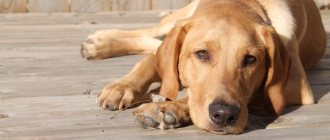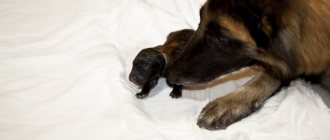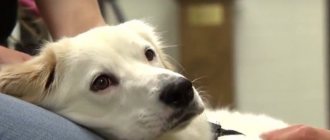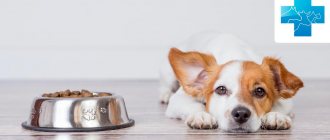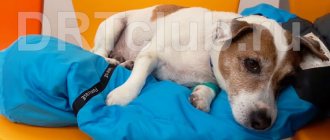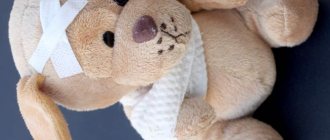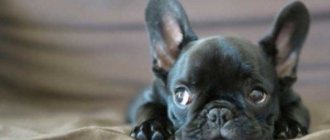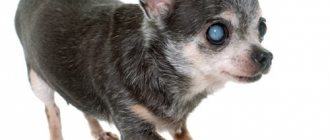Most owners get a dog as a friend and even a family member. As the pet gets older, if breeding is not planned, owners often decide to sterilize or castrate.
Sterilization of dogs involves ligation of the fallopian tubes/sperm ducts of the animal. That is, sex hormones continue to be produced and sexual behavior does not stop, but the chance of pregnancy is excluded. Castration is the removal of the main sex glands (ovaries and testes). However, nowadays, in order not to confuse owners, services in veterinary clinics more often indicate castration of males and sterilization of females (although during sterilization the uterus and ovaries are completely removed).
For females, both castration and sterilization are abdominal operations; they are somewhat heavier than males. Therefore, you need to know how to care for your dog during the postoperative period.
Preparing the dog for surgery
As a rule, it is advisable to make an appointment for scheduled sterilization first. By calling, you can find out whether you will need to bring anything with you (for example, a veterinary passport or other documents) and whether it will be possible to leave the dog after the operation for some time in the clinic so that it will be under the supervision of a specialist while recovering from anesthesia.
- Before surgery, the dog should not be fed for 12 hours. You should drink no later than 4 hours in advance. The fact is that after the administration of sedatives (anesthesia), most animals experience vomiting and the dog may simply choke on the vomit.
- You can and should walk before surgery, but you should not allow excessive stress. It is enough to wait for the dog to simply do all the “things”.
- It is not advisable to carry out sterilization during estrus, because During this period, the dog’s uterus is supplied with blood more intensively, the vessels approaching the uterus are filled with blood. Damage to the vessel during surgery is fraught with excessive blood loss in the animal. Therefore, before going for a planned operation, it is better for the owner to make sure whether the dog is in heat or not.
Every dog owner should understand that anesthesia is the administration of sedatives and narcotic drugs that can cause an allergic reaction in the animal, regardless of health and age. To reduce the risk of such a reaction, in many clinics, immediately before surgery, the dog is prepared with special medications (premedication). However, owners must be made aware of all the consequences and potential reactions to anesthesia!
First day
When arriving home, the pet requires increased attention, especially in the first 24 hours. After recovering from anesthesia, he has poor spatial orientation and cannot always get up to go to the toilet. If your dog whines, it means he is in pain, you should give him a painkiller tablet.
Expert opinion
Anna Abramenko
An avid dog lover. Experience in veterinary medicine since 2009.
Ask a Question
It is prohibited to use a heating pad; it can cause internal bleeding.
It is better to place the animal on the floor, because it can easily fall from the sofa or other surfaces due to lack of coordination. A place should be chosen without drafts and away from heating devices. To prevent your pet from freezing, you should lay a bed or blanket on the floor.
Until the dog finally wakes up, she will urinate on herself. You can’t scold her for this, you just need to put an absorbent diaper on the sunbed and don’t forget to change it as needed. Once every half hour, the animal should change the side on which it lies.
The first day after surgery the pet is inactive and sleeps a lot. You should provide him with maximum peace, keep small children and pets away. Every 30 minutes you need to monitor your breathing, pulse, and the condition of your mucous membranes.
To avoid dryness and pain in the eyes, you can use special drops. If your pet does not drink on its own, you should give it water from a syringe without a needle.
The first day for a dog after castration is the most difficult and, in many ways, decisive. The owner must provide her with maximum support and care and, if possible, always be nearby.
The dog is the first day after surgery. Coming out of anesthesia
To perform the operation, 3 methods of administering narcotic and sedatives are usually used. After sterilizing a dog, the anesthesia wears off within a day or two. Naturally, animals depart differently from each one.
- Inhalation (gas) anesthesia. The most effective and relatively non-toxic method with minimal side effects. The dog comes to his senses almost immediately after the gas supply apparatus is turned off. There is mild disorientation and decreased activity. The disadvantage is the high cost due to the special apparatus for anesthesia and the narcotic mixtures themselves.
- Analgesics + muscle relaxants. The most commonly used mixture, but it takes a long time for the animal to recover. Depending on the name of the drugs, the dog “wakes up” from 5-8 hours to a day.
- Epidural anesthesia + muscle relaxant. The mixtures are low-toxic and, as a rule, well tolerated. It is not done for small breeds due to the difficulty of insertion to the required depth into the epidural space of the spinal cord. With such anesthesia, the qualifications of the surgeon are very important. The dog recovers from such anesthesia for a maximum of 6-8 hours.
Caring for the dog immediately after sterilization should be appropriate:
- The pet is placed in a low place. Coordination of movements is still impaired, and the dog may not be able to calculate the strength for a usual jump on a sofa, bed or any other height.
- The dog is protected from drafts and low temperatures (can be covered with a light blanket). All processes in the initial postoperative period are slowed down and thermoregulation is also impaired. Any anesthesia slightly lowers body temperature and somewhat inhibits thermoregulation processes, so all risks of hypothermia should be completely eliminated!
- Fasting diet 10-12 hours maximum. Access to water is free. Any food intake can provoke vomiting, and in such a weakened state the dog can choke on vomit.
- After 10-12 hours, you can start feeding the dog a little with small portions of food. In the first two days, vomiting to water and food is allowed, because The stomach starts working gradually after anesthesia, so you can’t overfeed.
- You need to be prepared for inappropriate behavior of your pet while recovering from anesthesia. Disorientation, attempts to run in an unknown direction, sudden falling asleep while walking, whining, unsteady gait, possible involuntary urination. Doesn't always respond to nicknames. In this state, the main thing is not to let the dog hide somewhere where it will be difficult to get it out.
Over the next 2-3 days, the dog gradually completely recovers from anesthesia after sterilization, comes to its senses and behavior becomes normal. This period may proceed differently for each pet.
- The dog must be prescribed an antibiotic by injection. It is most effective to use ceftriaxone or sinulox - intramuscularly once a day, 1-5 ml per animal, depending on the size and intensity of the inflammatory process (1 bottle is diluted in 5 ml of 0.5% novocaine). Course – 5-7 days. The diluted solution is good for 24 hours. Sometimes Amoxicillin 15% is used at a dose of 0.1 ml/kg subcutaneously, once a day or every other day (a 10 ml bottle costs 165 rubles), but its power is often not enough and inflammation still breaks through.
Consequences of spaying and neutering a dog
Like any other surgery, sterilization has a number of complications that can arise. Typically, such complications accompany bitches who have reached the age of 7 years.
The dog may begin to gain excess weight due to changes in metabolism. To avoid this problem, you should reduce each serving of food and review your diet. Neutered dogs often suffer from urinary incontinence. In this case, it is important to find the true reason.
It is likely that the dog had urinary tract problems before surgery. Hormonal levels change, which leads to a weakening of the bladder. Lack of estrogen can also cause incontinence. Lack of estrogen often leads to baldness in female dogs. There is no prevention for this problem. Treatment is taking female hormones.
Knowing everything about complications in the postoperative period, you will eliminate the likelihood of developing a serious condition that could threaten the animal’s life. To summarize, we note the most common complications that should not be left without your attention:
- urinary incontinence;
- inflammation of sutures;
- seam rupture;
- addition of infection;
- internal bleeding;
- the appearance of a postoperative hernia.
How does a dog behave after castration and is it necessary? The animal may be lethargic, she will have no appetite, and there is a risk of chills, but not for long. At first after anesthesia, the dog will not be able to walk, roll over, or drink. This may scare you, but it’s completely in vain, this condition is considered the norm. You will have to help her with this in order to prevent the development of complications, and simply speed up the recovery process of your pet.
When is a veterinarian needed?
It is important to call your veterinarian promptly if the following situations occur:
- 2 days after the operation the dog refuses to eat and drink. Usually by this time the animal should be eating and drinking normally, and if this does not happen, it means that he is worried about painful sensations, do not hesitate and urgently call the doctor;
- discharge began from the wound. When the wound heals, it is dry. If you see pus or blood coming out, contact your doctor immediately;
- nausea and diarrhea. Often, anesthetics can cause nausea or diarrhea, which occurs as a result of stomach irritation. However, if your dog is vomiting after surgery, you should consult a doctor;
- swollen abdomen, lethargy and weakness. If your dog's shape changes, weakness increases without regaining energy, and the stomach becomes swollen, do not hesitate to call your doctor and make an appointment.
If you notice one of the symptoms that indicates that the dog is not going well through the rehabilitation period and is not recovering, call your veterinarian and tell him about it. Surround your pet with maximum care, monitor its condition and prevent its health from deteriorating. A dog, just like a person, experiences a difficult postoperative period, so do not skimp on attention and resources, follow all the doctor’s recommendations. After recovery, the dog will definitely thank you for your efforts and care with its affection and friendliness.
Currently reading:
- How difficult it is for dogs to endure and recover from anesthesia
- Games to choose for training a dog
- Everything about the Malinois dog breed, originally from Belgium
- Recommendations for obedience of a dog if it growls
Medicinal postoperative support
How can you relieve pain (usually it takes a day - maximum two and strictly as prescribed by the doctor, because there may be a conflict with the remains of anesthesia in the body):
- Meloxicam - intramuscularly at a dose of 0.2 mg/kg on the first day, then 0.1 mg/kg for another 1-2 days.
- Tolfedine – 4 mg/kg orally with food or water once a day (how much in tablets will depend on the dosage component).
- Rimadyl (carprofen) - administered subcutaneously at the rate of 1 ml of the drug for every 12.5 kg. Once a day. No longer than 3 days.
- Ketanov – 1 ml/13 kg maximum up to 2 times a day.
- Ketofen (ketoprofen) – 0.2 ml/kg once a day for no longer than 4 days.
- Travmatin - calculation 0.1-0.2 ml/kg, but not more than 4 ml per injection.
Treatment of seams (according to the instructions for the preparations):
- Vetericin spray;
- Chemi spray;
- Aluminumspray;
- Horhexidine;
- Betadine + sea buckthorn oil or rosehip oil;
- Levomekol ointment;
- Terramycin spray.
General strengthening agents:
- Vitam - from 1 to 4 ml subcutaneously, depending on the size of the dog, twice a week until the sutures heal.
- Gamavit - if for general preventive therapy, then 0.1 ml/kg is enough, if the dog is weakened, then 0.5 ml/kg. The general course is prescribed by the veterinarian, because can be administered daily or at intervals of several days, depending on the condition of the dog.
If the stitch is bleeding:
- Vikasol – 1 ml/5 kg intramuscularly twice a day at regular intervals. Can be used separately or together with etamsylate.
- Etamsylate - 0.1 ml per kg of body weight twice a day.
Overexposure at home
Overexposure in a residential building or apartment does not require luxurious conditions. On the contrary, it is better to remove carpets and expensive luxurious furniture from the room where the animal is kept. Sterilization is a tremendous stress for an animal. The pet is unlikely to be toilet trained, so be prepared for the possibility of puddles on the floor.
The premises for keeping the animal must be safe. The dog has the right to move around there and possibly chew. It is acceptable to lock an animal in a cage for a short time if you need to leave the house. It is important to distract the dog from the stress and anxiety it has suffered - play, pet, talk, calm.
One week after surgery (day by day)
1 day
Depending on the anesthesia used, the dog remains in narcotic sleep from 2 to 12 (14 hours). “Awakening” begins with lethargy, disorientation, and unsteadiness of gait. Hallucinations are possible. 1-2 involuntary urinations are allowed, because... the dog will not be able to immediately find the toilet (if the breed is small and it is in the house) and does not have the strength to go outside for this.
It is prohibited to administer any medications on your own without the consent of a veterinarian to speed up recovery from anesthesia!
It is advisable to stay close to the dog during these days. If you need to leave, leave it somewhere in a small enclosed area where the dog cannot injure itself if it tries to move.
During the first day, do not limit access to water and do not need to feed. If the animal does not drink, forcefully pour it into the mouth from a syringe or rubber bulb through the toothless edge, not very quickly, so that it has time to swallow. Start doing this when the first signs of coming to your senses are already noted.
When observing prolonged narcotic sleep, you should close your eyelids to prevent drying out of the cornea.
On the first day you need to be prepared for inappropriate dog behavior. The pet may jump up, try to run in an uncertain direction, fall, suddenly fall asleep, whine or bark, etc.
If it becomes clear that the dog is in pain when recovering from anesthesia, you can give an anesthetic injection with the drug recommended by the veterinarian.
Day 2
The dog is becoming more and more adequate. On day 2, you can start complementary feeding with easily digestible food, often, but in very small portions - about 1/4 of the usual. It is better not to give dry food, it is harder on the stomach than wet food. The gastrointestinal tract works slightly inhibited, so it should not be overloaded. Regurgitation is allowed in the first day or two after drinking water and/or food - this is an indicator of a slow acceleration of gastric motility. There is no need to be afraid.
If coldness of the extremities is noted, it is necessary to warm them - with a heating pad or rubbing. There are risks of hypothermia due to a slowdown in metabolism after anesthesia.
The dog should always be in sight, especially the small breed, which always tries to hide. On this day, all your needs are still managed indoors.
On the 2nd day, the dog should relieve itself, there should be an appetite, and the general condition should visually improve. Body temperature should be within normal limits (37.6-39°C). Painkillers are injected on demand, but usually by the end of these days the pain subsides on its own.
Day 3
The dog is fully conscious, reacts adequately and with interest to what is happening, asks to go to the toilet outside (if it is large) or consciously and promptly goes to its home toilet (if it is small).
On day 3, severe postoperative swelling usually appears in the suture area. If there is no additional pain syndrome, nothing additional is required, treatment should be carried out as usual.
If by this day there have been no acts of bowel movement, you should give the pet a microenema once - 1 or 2, depending on the size of the dog (Microlax, up to 80 rubles / piece) and inject a cerucal to stimulate gastrointestinal motility (0.5-0. 7 mg/10 kg) twice a day. As an additional laxative, you can give lactulose or drugs based on it (Duphalac, Lactusan) for several days. The dosage is calculated by weight according to the instructions.
If there is no urination, the dog is given a No-Spa tablet or an injection, after 15-20 minutes the belly is gently massaged in the area of the bladder and it is expected that urination will still occur. If not, you need to go to the veterinary clinic; you may need to insert a urinary catheter.
Body temperature must be measured. If two readings are too high within 24 hours, you should start taking or injecting an antibiotic if this was not done immediately after the operation, or replace it with a stronger one if you did. If after starting a course of antibiotics the temperature does not return to normal, you need to take your cat to the veterinarian; it may be a viral infection.
At low temperatures (below 37.5°C), consultation with a veterinarian is also required.
The dog is still not allowed to walk long distances - they went outside, relieved themselves, and went home. If the housing is in a multi-storey building, then it is better to take the pet outside in your arms so that it does not jump up the steps - it is too early.
4 day
The dog is active, general health is satisfactory, there is adequate interest in food and drink, the intestines and urine are emptied in a timely manner.
5 day
Starting from this period, you can not be afraid to leave the animal on its own and allow you to walk around the apartment a lot, you can let it out for a walk in the yard (if there was previously free access to the street), you can allow it to climb onto low surfaces, and not run up the steps for long.
By this time, postoperative swelling in the suture area usually subsides, redness disappears, and in some places traces of the first scarring of the wound may appear. The blanket has not yet been removed, and the belly cannot be licked.
6-7 days
The dog practically does not pay attention to the blanket, is active, with a good appetite and adequate thirst, runs, jumps a little, sleeps in its sleeping or favorite place. There is no longer any pain, all physiological needs are dealt with naturally and in the usual way, without attracting special attention from the owner.
Externally, the postoperative wound is the same color as the skin of the abdomen, hair begins to grow, and the scarring process is visible. There should be no redness, bleeding, swelling, etc.
The sutures are not removed yet, it still lasts for 10-14 days, depending on the suture material. Dogs are very active animals; the risk of sutures on the skin coming apart still remains.
Important arguments for sterilization
What pushes people to do such an act? First of all, this is done to avoid the appearance of offspring. These operations have other undeniable advantages. Pros of sterilization:
- You can safely walk in the yard without fear of aggression from surrounding males. There will be no gatherings of other people's dogs near your home.
- A sterilized male dog becomes more balanced in his psyche.
- You definitely need to consider the possibility of performing the operation if you also have other pets. This will reduce the risk of conflict situations. At the same time, the problem with the desire to mark territory is being solved.
- The female will maintain her health and will be protected from sexually transmitted diseases. Dogs have a huge number of them. Imagine how risky a bitch is when surrounded by a pack of males. Diseases of the reproductive organs can cause a deterioration in the quality of life and early death of your pet.
- The life of a pet will be several years longer.
- He will be easier to train.
- Finally, when considering the pros and cons of sterilization, it should be noted that it is protection against unplanned offspring. This is the most humane way to reduce the number of mongrels, who very often become homeless solely due to human fault.
As you can see, there are many positive aspects to this. But when owners are interested in how much it costs to sterilize a dog, many refuse such an idea. This is an abdominal operation that cannot be free. But almost every city has preferential sterilization points. They are designed primarily for homeless animals. Therefore, if a common favorite has settled in your yard and everyone feeds it, then you should think about preventing it from starting to bear offspring. Only at first glance there is nothing wrong with this. After all, puppies will suffer from cold and hunger, and children may offend them. A dog that lives in such conditions cannot eat properly, and at the same time, feeding the offspring will lead to exhaustion of the puppies. What will happen to the babies later if no one takes them?
Nuances of postoperative care
What you need to do:
- Strictly monitor your diet throughout your life, minimizing the risks of obesity. After sterilization, the metabolism changes greatly, so many of the usual high-calorie treats and feeding on demand will have to be canceled. Not only the calorie content of the feed is reduced, but also the frequency of feeding and the size of the portion eaten at a time. For convenience, you can switch your dog to food for sterilized individuals.
- Monitor your general health, excluding the development of various internal diseases and minimizing the risks of infection with various parasites (fleas, ticks, worms). The body, weakened by the operation, is difficult to tolerate illness and has difficulty reacting to parasites.
- Monitor the condition of the seam and blanket.
- Give plenty to drink.
- Go out for short walks as usual.
- Lift small animals in your arms without sudden movements or pressure on the stomach.
What not to do:
- Walk actively in the first two weeks after surgery, run and jump.
- Remove the blanket from the animal until the postoperative wound has completely healed.
- Treat the seam with something containing alcohol to avoid skin burns.
- Allow the first few days to sleep near heaters or on hot radiators. The environment should be warm, not hot; heat reduces the ability of blood to clot and dilates blood vessels.
- Lift in your arms, holding only the front paws.
- Leave food out all day. Food should be exposed directly during feeding for a maximum of 15-20 minutes. It is necessary to eliminate the risk of poisoning from missing feed.
Contraindications for castration
Before surgery, the veterinarian examines the dog to rule out possible contraindications. The main factors influencing the decision to castrate an animal:
- inappropriate age - up to 5 months or older than 6 years (without urgent medical need);
- kidney and cardiovascular diseases;
- less than a month has passed since vaccination;
- loss of appetite, behavior, loss or dull color of the dog’s coat;
- weakened state after illness.
What should you be wary of?
As with any operation, some complications may arise after sterilization. It is better to call a doctor if you notice in your dog:
- blood in urine;
- purulent discharge from the suture;
- lack of urination for more than a day after surgery;
- increased body temperature;
- vomiting
If the dog does not go to the toilet "in a big way", it is not so dangerous. This is considered normal for up to 3 days (even with a good appetite), since anesthesia slows down intestinal motility (see what to do if your dog is constipated). If the dog has not passed for more than 3 days, it can be given Vaseline oil from 5 to 30 ml, depending on the size of the dog. The oil is sold at the pharmacy and costs 60 rubles per 100 ml.
How long does it take for a dog to recover after sterilization?
Conventionally, the period after surgery can be divided into 3 parts:
- recovery after anesthesia (12-24 hours);
- healing period of sutures (on average 10-14 days);
- complete recovery of the dog (up to a month).
The timing of each period depends on the characteristics of the dog’s body, its immunity and, most importantly, on the type of operation. After laparoscopic sterilization, the stitches are minimal, require virtually no treatment, and the dog’s recovery is faster. The specific timing of each period should be checked with your doctor.
Processing the seam
After sterilization, the suture is located on the dog’s underside, along the so-called white line - from the navel to the tail. The length of the suture depends on the size of the dog and can be from 2 to 10-15 cm. Doctors recommend removing the sutures 10-14 days after the operation. In some cases, removal is carried out earlier (if healing is good or, conversely, if the suture material is rejected). The seams are treated daily 1-2 times a day.
As a rule, seam treatment does not cause any discomfort to dogs. On the contrary, some pets enjoy having their belly scratched, especially after a few days when the stitch may itch a little as it heals. Cats, for example, endure this procedure much more painfully, because... their groin area is “inviolable” for strangers.
Immediately after the sterilization operation, the dog is put on a special blanket so that it cannot lick its stitches. You should immediately purchase a second blanket to replace it, because... In the first days after sterilization, there may be slight bleeding from the suture. In addition, the blanket will become dirty during the walk.
It is most convenient to treat the seam with sterile gauze wipes. Ready-made napkins are sold in packs of 10 pieces at the pharmacy (price 10-15 rubles). You can use a sterile bandage and simply fold the piece into several layers.
The napkin is generously moistened with a solution of hydrogen peroxide and applied along the entire length of the seam. It is preferable to use peroxide because... it will well soak up the bloody crusts, which must be removed. Use a second napkin along the seam to remove all dirt so that the seam is clean. Then blot dry.
After general wound hygiene, the suture is treated with any wound-healing and anti-inflammatory agent (see section Drug postoperative support).
The seam can then be treated with the following means (optional):
The ointment is applied to the cleaned seam 1-2 times daily. A sterile gauze pad is applied to the seam on top and a blanket is put on top. A 40 g tube of ointment costs 110 rubles. |
Spray TerramycinThis is a veterinary drug. You can treat the seam with it once every 3 days. This may be beneficial for owners of aggressive dogs, or for dogs kept in kennels and kennels. The cost of the aerosol is 520 rubles. |
Aluminum sprayAfter application to the seam, a thin film is formed that prevents the penetration of bacteria and contamination of the wound. Treatment can be carried out daily. The price is about 800 rubles. An analogue could be the “Second Skin” spray, its cost is 380 rubles. |
Preparations for seam treatment
The following drugs can be used directly to treat a postoperative wound and adjacent tissues:
- The well-known Miramistin. This is the most common and relatively inexpensive drug suitable for daily use. But! If there are signs of at least some inflammation (slight swelling, oozing ichor), it is better to choose something more powerful.
- Chlorhexidine is no less popular as an antiseptic. This is what many veterinarians recommend using, since the bactericidal effect of this product is much stronger.
- If it is necessary (in the presence of an inflammatory process) to treat the seam itself, then veterinarians advise using synthomycin liniment and levomekol ointment. The main condition is that the product must be applied in a thin layer, evenly distributing it over the surface of the seam.
- In cases where none of the above is at hand, you can treat the skin around the seam with an alcohol tincture of iodine and ordinary brilliant green. It is strictly prohibited to pour these preparations onto the seam itself, as this will inevitably cause a chemical burn to the tissue!
Assessing the condition of the seam
Normally, with good healing a few days after surgery, the suture:
- dry;
- skin without redness;
- swelling gradually disappears (exceptions may include dogs with thick skin (Shar Pei, Chow Chow, Pugs, Bulldogs) or overweight);
- after 7 days, the wound gradually heals and the skin becomes intact.
A poorly healing suture can be caused by infection or rejection of the suture material.
- Outflows (possibly purulent) are observed from the suture;
- the seam area is hot;
- the treatment causes pain to the dog;
- the suture is swollen, red;
- the edges of the wound may diverge.
In severe cases, repeated suturing may be required (in this case, the dog will most likely be under anesthesia again, but not as deeply). The edges of the wound are excised for better healing, treated with antiseptic solutions and the suture is applied again (in case of rejection).
Nutrition
Changing your diet is an important part of your dog's recovery after surgery. For the first 24 hours, the animal does not need food, just clean drinking water is enough. Due to a weak swallowing reflex, food can enter the bronchi, leading to lack of oxygen and death.
The next day after surgery, the dog begins to be given food in liquid or pureed form (for example, fermented milk drinks, vegetable puree, poultry broth). It should not cause alarm if the pet at first eats less than usual and is picky.
After castration and sterilization of an animal, its nutrition necessarily changes. Dogs that have no interest in hunting find joy in food and consequently gain weight quickly. You should not allow your pet to become obese.
You need to remove high-calorie foods from your diet, reduce the number of meals and portion sizes. A convenient option for the owner is to feed the sterilized dog with special food.
All possible postoperative complications
- Any deviations in body temperature: prolonged hypothermia (decrease) or hyperthermia (increase). It is not without reason that dog owners are required to measure their general body temperature during the first few days. If the readings are below 37°C, this is a reason to immediately wrap or cover the animal with any natural fabric or blanket, placing it on a heating pad (if the size of the dog allows it), and contact the operating or duty veterinarian. If during the first 3 days the temperature remains above 39°C, especially despite the antibiotic being administered, then no measures can be taken on your own. Go to the vet immediately!
- Intra-abdominal bleeding. If traces of fresh blood leaking from the suture or genitals were found, the suture itself is clearly painful, swollen, but the dog has pale mucous membranes, then a visit to the veterinary clinic should be carried out immediately. These are all signs of internal bleeding. If the fact is confirmed, a repeat operation will have to be performed, because there is a risk that the dog will die from blood loss.
- Lumps or protrusions in the area of a suture wound should always be alarming. Consultation with a specialist is required. The most harmless thing that can happen is local postoperative swelling or abnormal growth of granulation tissue (“young” skin). These changes go away on their own. But if it is an abscess or tumor, only a surgeon can help.
- Decay of a postoperative wound. There can be many reasons for suppuration, but the main factor is bacterial contamination of the suture. If topical medications do not eliminate this, you need to contact a veterinarian. It may be necessary to clean the edges of the wound, removing purulent signs and re-stitching.
- Swelling, swelling and redness of the suture. These phenomena, without significant pain, normally appear on the 2-3rd day, and disappear on the 5th day. If it takes longer and pain increases, see a veterinarian.
- Urinary incontinence in dogs. In some cases, 3-7% of small breeds and 9-13% of large breeds develop urinary incontinence after spaying. It is important to understand that the reason is not an incorrectly performed operation or postoperative infections, but an individual hormonal restructuring, when the sensitivity of the smooth muscles of the bladder decreases, which, in turn, affects the activity of the sphincter. The period during which the complication develops ranges from several days to several years. Treatment is medicinal or surgical.
Errors when processing seams
Beginner breeders make many common mistakes. Some of them are relatively harmless, while others can lead to very serious consequences:
- We have already indirectly pointed out this above - it is strictly forbidden to fill the seam itself with iodine or brilliant green, as this leads to the development of chemical burns to the tissue.
- The seams must be handled gently and carefully, avoiding strong and rough pressure. In the most “advanced” cases, rough treatment can even lead to suture separation, which will require repeated surgery!
Result of the operation
After castration (complete removal of the uterus and ovaries), estrus in dogs stops. After sterilization, dogs remain in estrus, matings may even occur, but pregnancy simply will not occur.
Incontinence in dogs is a common consequence of sterilization. On average, it develops 3 years after the intervention, but there are cases where urinary incontinence first appeared only 10 years after the operation.
A dog's behavior usually changes slightly after sterilization. Some owners note that the dog has become much calmer, aggression (if any) has decreased, and the level of activity in general drops somewhat.
Metabolism also changes. Dogs prone to obesity should receive dietary food, or there are food lines designed specifically for neutered animals. Their calorie content is lower than for regular dogs.
At what age and when is surgery indicated?
The optimal age is 7-12 months. By this age, animals reach sexual maturity and have good regeneration. They recover quickly and easily tolerate anesthesia.
Earlier intervention is not practiced in Russia. In Europe, on the contrary, it is recommended to operate on bitches 2-3 weeks before the first heat.
“
Please note that, contrary to popular belief, not only males, but also females can be neutered. This operation involves total excision of the ovaries and testes, which are responsible for the production of sex hormones.
Sterilization is also applicable to both sexes, but it only involves tightening the fallopian tubes or seminal ducts. Because of this, sterilized pets lose their reproductive function while maintaining their sexual instinct, and castrated pets lose both.
